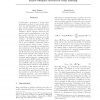Free Online Productivity Tools
i2Speak
i2Symbol
i2OCR
iTex2Img
iWeb2Print
iWeb2Shot
i2Type
iPdf2Split
iPdf2Merge
i2Bopomofo
i2Arabic
i2Style
i2Image
i2PDF
iLatex2Rtf
Sci2ools
JMLR
2012
2012
Krylov Subspace Descent for Deep Learning
In this paper, we propose a second order optimization method to learn models where both the dimensionality of the parameter space and the number of training samples is high. In our method, we construct on each iteration a Krylov subspace formed by the gradient and an approximation to the Hessian matrix, and then use a subset of the training data samples to optimize over this subspace. As with the Hessian Free (HF) method of Martens (2010), the Hessian matrix is never explicitly constructed, and is computed using a subset of data. In practice, as in HF, we typically use a positive definite substitute for the Hessian matrix such as the Gauss-Newton matrix. We investigate the effectiveness of our proposed method on deep neural networks, and compare its performance to widely used methods such as stochastic gradient descent, conjugate gradient descent and L-BFGS, and also to HF. Our method leads to faster convergence than either L-BFGS or HF, and generally performs better than either of t...
| Added | 27 Sep 2012 |
| Updated | 27 Sep 2012 |
| Type | Journal |
| Year | 2012 |
| Where | JMLR |
| Authors | Oriol Vinyals, Daniel Povey |
Comments (0)

